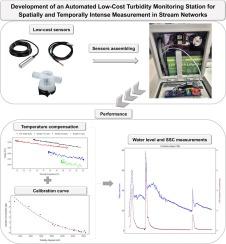低成本悬浮沉积物和水位自动监测站
IF 2
Q3 ENGINEERING, ELECTRICAL & ELECTRONIC
引用次数: 0
摘要
使用低成本传感器和开放源代码有助于提高环境监测的空间分辨率和灵活性,从而获得更多信息,克服传统商业传感器的局限性。使用浸没式传感器测量水体浊度可能存在问题,因为快速的生物污损需要经常到现场拆除、清洁、校准和更换传感器。因此,我们设计了一种自动化系统,使用市场上销售的低成本传感器,从溪流中抽水,对浊度进行采样,然后清除剩余的水,使浊度传感器在两次测量之间保持干燥,从而大大减少了生物污染问题,并最大限度地降低了运行成本。我们的监测站能够估算出 0 至 6 克/升之间的悬浮沉积物浓度,均方根误差 (RMSE) 约为总范围的 5%,符合典型的研究和运行研究要求。结果表明,该监测站能够长期监测水位和浊度,由于其具有吹扫功能,无需清洗浊度传感器。我们证明,可以用相对较低的成本实现对集水区和排水管网内浊度的空间密集测量,从而更好地了解悬浮沉积物的主要来源及其时空变化。本文章由计算机程序翻译,如有差异,请以英文原文为准。

An automated low-cost monitoring station for suspended sediments and water level
The use of low-cost sensors, with open-source code, facilitates greater spatial resolution and flexibility of environmental monitoring, thus generating more information and overcoming limitations of traditional commercial sensors. Measurement of water turbidity using submerged sensors can be problematic in that rapid biofouling requires frequent site visits to remove, clean, calibrate and replace the sensor. We therefore designed an automated system using low-cost commercially-available sensors that pumps water from the stream, samples it for turbidity and purges remaining water, leaving the turbidity sensor dry between measurements, thus greatly reducing the biofouling problem and minimizing operation costs. Our station was able to estimate suspended sediment concentrations between 0 and 6 g/L with a root mean square error (RMSE) around 5 % of the total range, which meets typical research and operational study requirements. The results showed that the monitoring station is capable of monitoring water level and turbidity for long periods without the need of cleaning the turbidity sensor, due to its purge function. We demonstrated that spatially intense measurement of turbidity within catchments and drainage networks can be achieved at a relatively low cost, which allows a better understanding of the main sources of suspended sediments and their spatial and temporal variability.
求助全文
通过发布文献求助,成功后即可免费获取论文全文。
去求助
来源期刊

HardwareX
Engineering-Industrial and Manufacturing Engineering
CiteScore
4.10
自引率
18.20%
发文量
124
审稿时长
24 weeks
期刊介绍:
HardwareX is an open access journal established to promote free and open source designing, building and customizing of scientific infrastructure (hardware). HardwareX aims to recognize researchers for the time and effort in developing scientific infrastructure while providing end-users with sufficient information to replicate and validate the advances presented. HardwareX is open to input from all scientific, technological and medical disciplines. Scientific infrastructure will be interpreted in the broadest sense. Including hardware modifications to existing infrastructure, sensors and tools that perform measurements and other functions outside of the traditional lab setting (such as wearables, air/water quality sensors, and low cost alternatives to existing tools), and the creation of wholly new tools for either standard or novel laboratory tasks. Authors are encouraged to submit hardware developments that address all aspects of science, not only the final measurement, for example, enhancements in sample preparation and handling, user safety, and quality control. The use of distributed digital manufacturing strategies (e.g. 3-D printing) is encouraged. All designs must be submitted under an open hardware license.
 求助内容:
求助内容: 应助结果提醒方式:
应助结果提醒方式:


